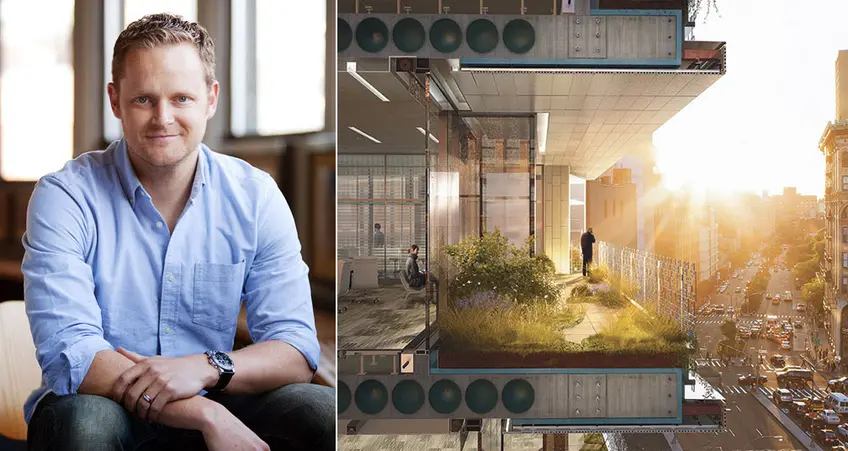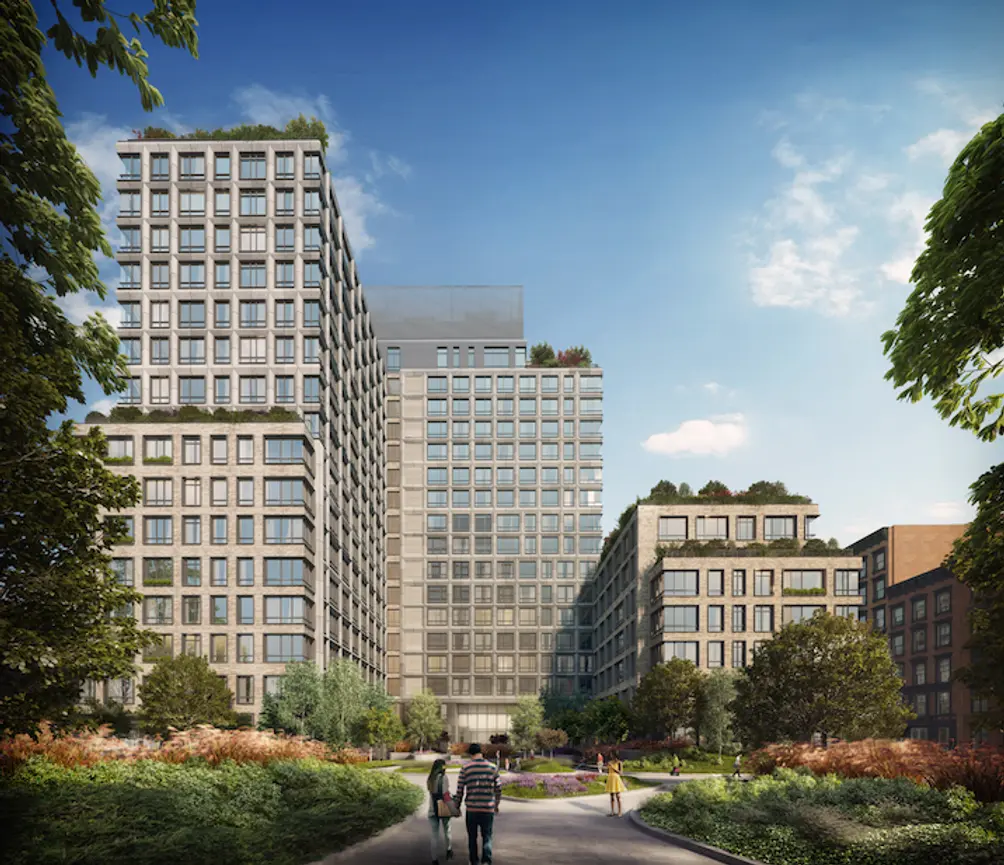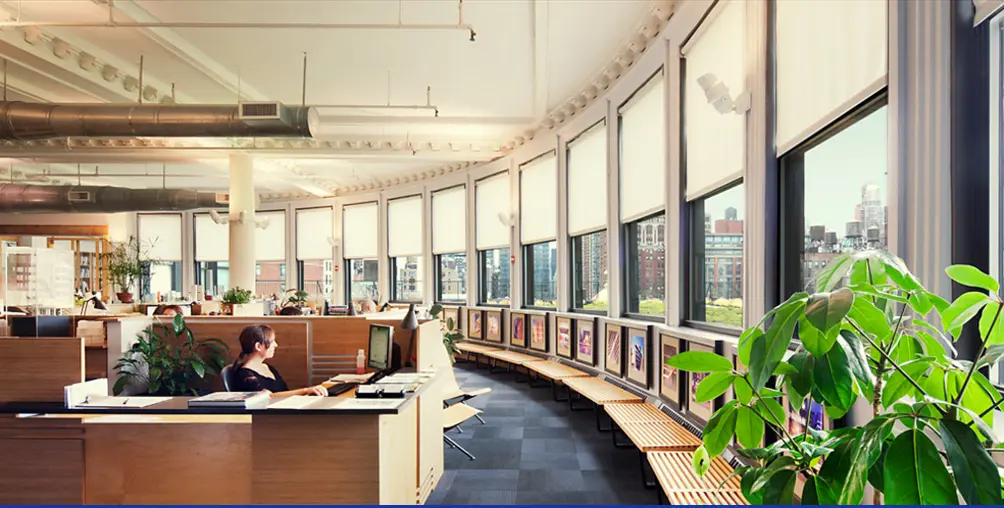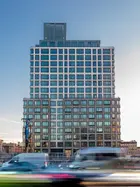 Brandon Specketer (l); A section through 300 Lafayette, a new office building by COOKFOX (r)
Brandon Specketer (l); A section through 300 Lafayette, a new office building by COOKFOX (r)
COOKFOX architects use biophilic design principles. The basic assumption of biophilic design is that humans have a deep, innate connection and love of nature. By increasing the connection of the built world to its natural environment, you can increase the overall happiness and well being of a building’s inhabitants.
In this article:
Recently, we spoke with Brandon Specketer, a Partner at COOKFOX, about biophilic design.
How do you explain biophilic design?
Social psychologist and biologist E.O. Wilson popularized the term biophilia in 1984. At that point it was not necessarily how it applied to design specifically, but Wilson’s exact definition of biophilia was “the innate emotional affiliation of human beings to other living organisms.”The COOKFOX definition is that people feel good when they are connected to nature. That’s the simplest way to describe it. That has driven our mission statement about the environment and sustainability and how that extends into cultural and social sustainability. Our work should connect people to nature in small, big and meaningful ways across all scales.
The reason why we have this connection to nature all ties into our own evolution preferences, the way we’ve adapted over time. As humans, we're automatically drawn to physically and mentally healthy spaces. Our bodies know that these spaces reduce stress, help enhance creativity, and help us think clearer. Hospital research even shows biophilic design helps expedite healing. We are architects and we are helping propagate this. As the world urbanizes, these qualities are becoming even more important.
What is driving the demand for biophilic design now?
There is a broader cultural shift toward people understanding the importance of this connection to nature. Over half of the world’s population lives in cities. And even though we are living in urbanized areas and enjoy all the activities, amenities and transportation it offers, we still want that connection.It’s picking up steam, the same way the green movement has shifted the marketplace. Most people understand recycling and lowering energy to be almost commonplace. It’s the right way to live and now. With many more people in urban environments, and especially more people in NYC, we’re looking at microhousing for solutions to deal with density. We need density but we also need that view to the horizon—to view green space and natural daylight.
 Central Park
Central Park
For example, that fact New York City decided to carve out prime real estate for one of the largest parks in the world shows that. Central Park was created so people would have a relief. It’s always been a part of the understanding of what people need. But now there are a lot more studies and a lot more science helping back up this kind of obvious connection that we all know is needed in all aspects of life, from education to healthcare.
You can see this in the demand in real estate—how much apartments sell for if they have terraces or not. It is recognized in real estate but it also kind of started with the general green movement with the stress on natural and low VOC materials. Let's not breathe in industrial chemicals in our home, that’s obviously not a natural way to live. Let’s filter our environment. All of that is part of this connection.
Are there general biophilic principles you can apply anywhere or are they site specific?
For us, it’s always site specific. There are certain things you can do on some buildings you can’t do on others. If you’re designing a 40- or 50-story residential skyscraper, it’s easy to orient living spaces toward nature. But if you’re working on brownstone renovation or tenement, there will be a different set of actions. It is very site specific but in a dense urban place there are some universal things you can do in the building design, like prioritizing areas for planting to occur. Or, if you are lucky enough to live on an island, how do you prioritize views to the river? Can the building be shaped to maximize southern exposure? Or if it faces north, how can you allow for as much light as possible? Healthy natural material selection is also a universal principle in biophilic design. 550 Vanderbilt, Brooklyn
550 Vanderbilt, Brooklyn
Biophilic design isn’t tied to a single office or residence, but it works for everyone in the building and the surrounding community as well. Our residence at 550 Vanderbilt Avenue in Brooklyn is an example of this.
 550 Vanderbilt, Brooklyn
550 Vanderbilt, Brooklyn
Can you tell me more about the biophilic features of 550 Vanderbilt?
One of the biggest and easiest things for us is that we have never met a surface we haven’t wanted to plant green. We term it the "5th facade." It’s not just a roof or building setback, it has the potential of being your private terrace. We plan for that landscape to be more than part of the immediate experience of that space. If you’re higher up and you’re looking down onto that landscape, it might be the only green you can see for 5-10 blocks.At 550 Vanderbilt, we shaped the building so that there would be significant landscaped areas, setbacks, rooftops, and terraces. The massing is designed to address two very different things: It's been shaped to have the density we were asked to put on the site, that is the amount of apartments and residents; and it respects the historic scale and character of the neighborhood. 550 Vanderbilt steps from a low-rise to a high tower but there are multiple levels that create terraces and setbacks for plantings. Some are private terraces, but there is also a public green space for all the residents in the building. We also built in planter boxes outside the windows spaced around the lower levels. This was something we saw around the neighborhood that we felt contributed to its character.
We've also specified the use of natural materials and 550 Vanderbilt also has large operable windows. We made them as large as we could so residents can swing their window open and take in the adjacent eight-acre public park. You can also hear the wind blow, the birds chirping, and the plants rustling on your window ledge.
We went for LEED Silver certification to make sure the metric was right, not only what we think is inherently right. We wanted to measure the performance of the building as well.
How much do LEED certification and biophilic overlap?
There is clearly overlap. LEED primarily began as a tool to measure energy and water performance and how its use in a building impacts the surrounding environment. The program has grown leaps and bounds to measure health and wellness since. Neither LEED nor biophilia constrains the other, they help support each other. For example, using low VOC materials and natural or recycled materials is an aspect of LEED that can support biophilic design. LEED is also growing to look toward health and wellness—i.e. how do we look at studies and how can we put a metric to it so we can design toward it. They are not mutually exclusive and one benefits the other.For biophilic design, no one sat down and said it is a prescriptive thing to do. There are the 14 patterns of biophilic design, but there is a lot of flexibility when it comes to what you can do in those realms. There was a recognition that these could be organized into areas.
 The COOKFOX studio
The COOKFOX studio
In our studio we also have natural analogs. The column capitals on the ceiling have leaf patterns and branches woven into the doric and corinthian columns and pilasters. The leaf pattern is a natural analog to what happens in history.
Even though many people don’t know what biophilic design is, is it good to have a term for it?
In various ways, designers have been looking to nature for ages. But not until the late 1980s was there an academic approach to it.Architecture in 1920s and 1930s did away with ornamentation to get fresh air and better views. They understood the balancing of natural light. Biophilic design has all been inherent, but only recently has a term been added to it. It does help explains what it is. Now there's a body of studies that people can reference.
The part we love about it is that it goes across multiple professions and it covers almost everything. It’s not just about architecture with a capital “A.” Now there are people that are actually studying this so we can justify things, like if you do A, then B will happen. The Heschong Mahone studies for educational research found that natural daylight in schools increase test scores. Tests in the medical community show that even a single view of a single tree or of the sky can help healing rates in hospitals.
Similarly, productivity in offices greatly benefit from this. Companies that want to attract and maintain the best talent want beautiful buildings and great amenities like modern cafeterias, free transportation and landscaped areas. All of the big, forward-thinking companies know that there are huge payoffs to this. It's proven that employees will use fewer sick days and be more productive. The term “presenteeism” is used in offices where people can’t stay focused. For example, in offices with cubicles, all you can see when you look up is the same thing, more cubicles. If you can look up and look at sky, you can regain your focus a lot quicker.
For companies, the biggest expenditure is human capital. If you can help create a healthier and more productive environment, everyone benefits. Having that term biophilia with applied research under that umbrella makes it easier for us to talk about and justify certain things we feel are very important in the designs we want to move forward with.
Wal-Mart studied the effects of natural light from a pure business standpoint. They split a store in half so that there were skylights on one side and none on the other. The area that had skylights performed better, and they thought it might be a fluke—the half of the store that did better had grocery and cleaning items, the other side clothing and electronics. So they switched the entire store around and the side under the natural light still did better.
The part I love about biophilic design is the way it inherently makes you feel. And now this can all be backed up by hard research and data, and that’s the most interesting thing. You can’t change behavior and perceptions unless there is something concrete to help people to enact change.



 6sqft delivers the latest on real estate, architecture, and design, straight from New York City.
6sqft delivers the latest on real estate, architecture, and design, straight from New York City.
